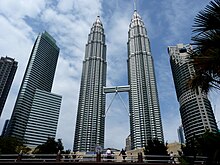Malaysian economy

Kuala Lumpur, financial centre of Malaysia and its cultural hub.
|
|
| Currency | Ringgit |
|---|---|
| Calendar year | |
|
Trade organisations
|
APEC, ASEAN, IOR-ARC, WTO, TPP |
| Statistics | |
| GDP |
|
|
GDP growth
|
|
|
GDP per capita
|
|
|
GDP by sector
|
(2016) Agriculture: Industry: Services: |
|
|
|
|
Population below poverty line
|
|
|
|
|
|
Labour force
|
|
|
Labour force by occupation
|
(2012) Agriculture: 11.1% Industry: 36% Services: 53.5% |
| Unemployment |
|
|
Main industries
|
|
|
|
|
| External | |
| Exports | $175.7 billion (2015 est.) |
|
Export goods
|
semiconductor & electronic products, palm oil, liquefied natural gas, petroleum, chemicals, machinery, vehicles, optical & scientific equipment, manufactures of metal, rubber, wood and wood products |
|
Main export partners
|
|
| Imports | 147.7 billion (2015 est.) |
|
Import goods
|
electrical & electronic products, machinery, chemicals, petroleum, plastics, vehicles, manufactures of metal, iron and steel products |
|
Main import partners
|
|
|
FDI stock
|
$77.4 billion (31 December 2010 est.) |
|
Gross external debt
|
$213.9 billion (est. 2014) |
| Public finances | |
| Revenues | $65.72 billion (2013 est.) |
| Expenses | $79.4 billion (2013 est.) |
| Economic aid | $31.6 million (2005 est.) |
|
|
|
Foreign reserves
|
|
The economy of Malaysia is the third largest in Southeast Asia, despite ranking seventh in terms of population size amongst all ASEAN countries. By extension, Malaysian quality of live is therefore significantly much higher than Indonesia and Thailand. Malaysia also featured the 35th largest economy in the world. Its economy is the sixth most competitive national economy on the Asian continent after Singapore, Qatar, Israel, United Arab Emirates and Japan based on Global Competitiveness Report 2017 . Its economy is more competitive than Iceland, China, Spain, Mexico and South Korea.
Due to more equal wealth distribution through government effort such as generous pension scheme, cash transfer, elderly benefits, free primary and secondary education, free public healthcare, grants for businesses and subsidized university education, Malaysian citizens on average have a very affluent lifestyle relative to their peers in upper-middle income countries like Mexico, Turkey or Brazil with income per capita of 27,681 PPP Dollar or 9,560 nominal US Dollar in year 2016. This makes it the third wealthiest in Southeast Asia after the smaller city-states of Singapore and Brunei. It shy just 2200 US Dollar from World Bank high income country definition. Malaysia has a newly industrialised market economy, which is relatively open and state-oriented. The Malaysian economy is highly robust and diversified with the export value of high-tech products in 2015 standing at 57.258 billion USD, the second highest after Singapore in ASEAN . Malaysia exports the second largest volume and value of palm oil products globally after Indonesia.
...
Wikipedia
